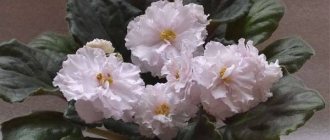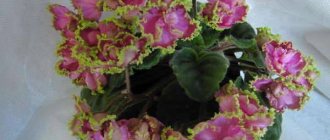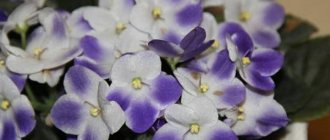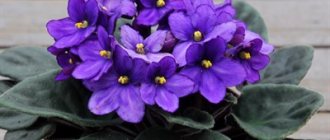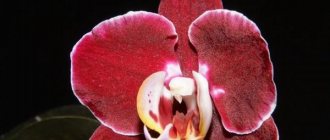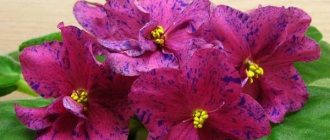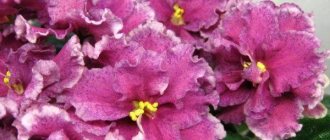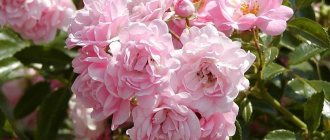Industrial varieties of violets
Industrial violets are the most popular varieties in the world because of their qualities.
They are grown in special nurseries using special technologies for sale to hobbyists and for decorating interiors during celebrations.
In European countries, these plants are used as disposable bouquets, and after use they are simply thrown away.
The positive qualities of industrial varieties include:
- resistance to extreme temperatures;
- undemanding to watering;
- fast growth;
- straight and strong peduncles;
- rich color and long flowering period;
- rosette symmetry;
- simultaneous flowering of a large number of flowers (the so-called swaying);
- good portability;
- loyal attitude to education.
Industrial violets are easy to care for.
These Saintpaulias have regular, slightly rounded leaves with a slight edge. The leaf color is predominantly green.
The flowers of industrial Saintpaulias are small in size and simple in shape, but there are also wavy flowers. Among industrial violets there are no large, double, variegated flowers with frills.
The colors of industrial Saintpaulias are limited to white, pink, blue and two-tone contrasting chimera.
No one will know about the authorship of these varieties or their names. In fact, each variety has its own author and name; it is not important when grown on an industrial scale.
Note! These violets are sold in pots filled with peat. The pot size is much larger than the plant needs. Abundant fertilization and treatment with hormones lead to long, abundant and bright flowering. After the flowering period has passed, it is very difficult to get the same effect from the plant.
Mini violets
These are beautiful, fragile and well-flowering flowerpots. The main thing is that they do not take up much space and are suitable for small apartments or premises.
miniature violets varieties
Different subtypes combine well with each other, creating a harmonious composition. Among the mini Saintpaulias it is worth highlighting:
- Chanterelle;
- Milk Rivers;
- First day of spring;
- Black Sea;
- Caramels.
The violet subtype Chanterelle is distinguished by its unusual color. The flowers are burgundy, crimson with a hint of beige or pink, the core is bright yellow. The leaves are colored light green. A beautiful contrasting color makes them stand out from others, despite the fact that its size is small.
Milk rivers are also bright mini violets. Tiny flowers are pure white or with a slight tint (blue, pink or purple). The edges of the leaves are cut off with scissors, as if on purpose, the shape is rounded, the color is dark green with white or beige stripes (even the photograph conveys this feature).
A popular subtype – First Day of Spring – is specifically designed to create a wonderful mood. The petals are painted in a rich bright pink color, the leaves are light green. The shape of the flowers is bells. And the leaves look like little hearts. A composition of these violets creates an atmosphere of inspiration in the room; you want to live and create.
Black Sea - white and purple Saintpaulias with dark green leaves. This species is suitable for those who truly appreciate the exotic and are tired of ordinary violets. They do not require strong lighting and bloom all year round. Their appearance is associated with summer, warm and carefree days of rest.
Caramels - the name already speaks for itself. The flowerpot looks like a composition of small candies. It looks bright, attractive and appetizing. Children's rooms are often decorated with such flowers.
Features of cultivation and reproduction
To plant, the leaf is lightly cut and air dried, then planted in the ground. For rapid and abundant formation of roots and leaves, a lean mixture is preferable: peat and sand in a 1:1 ratio. Small shoots feed on the mother leaf.
After 4-6 weeks, when young shoots are formed, they need to be transplanted into individual containers. The earth mixture should contain an increased amount of components in a 1: 1: 1 ratio:
- peat;
- coarse and clean sand;
- turf land.
Each sprout should have its own pot. Ideally, plants should not touch each other's leaves to avoid disease. If there is little space on the windowsill, Saintpaulia can form a rectangular rosette.
For further successful development and flowering, the young plant needs diffuse lighting, regular feeding and moist air.
Carefully! Violet does not like waterlogging of the soil and categorically does not tolerate water getting on the leaves.
Methods of propagation of the variety
The Swan Lake violet forms daughter shoots in large quantities - stepchildren, which can be used to propagate the variety. Stepchildren are formed in the axils of the leaves. They are separated with tweezers, an awl or a toothpick, so as not to damage the growth point. Each stepson must have at least 3-4 leaves.
The separated stepsons are planted in cups filled with drainage and a mixture of peat, sand and vermiculite. The composition for rooting should be as light and loose as possible. Stepchildren quickly take root in sphagnum moss.
The stepson placed in the substrate is covered with a plastic cup to retain heat and moisture. The cover can be removed after new leaves begin to grow. Stepchildren are ready for independent life as soon as the petioles of the leaves grow 4-5 centimeters in height.
Swan Lake violet can be propagated using shoots.
At this time, the young rosettes obtained from the stepsons are planted in small pots with a loose soil mixture. The first flowering of a rosette of the Swan Lake variety, obtained from a stepson, occurs 11-12 months after rooting.
An alternative way to propagate the variety is by rooting leaf cuttings. A leaf from the second row of the rosette is cut obliquely with a sharp knife or blade and placed in a glass of clean water. To disinfect, add an activated carbon tablet to the water.
After the roots have formed on the cuttings, the leaves are planted in cups with a soil-sand mixture. Babies on the cuttings are formed in 5-6 weeks. As soon as the diameter of the baby leaves reaches 3-4 centimeters, they can be separated from the mother cuttings and planted in pots with soil.
Dutch selection
In a flower shop, all violets are distinguished by their bright and long-lasting flowering, symmetrical rosette, and resistance to conditions and diseases. These Saintpaulias are grown industrially in greenhouses using the latest technology.
Dutch varieties of Saintpaulia are often not even listed, since special workshops are constantly inventing new varieties. We're not even talking about fatherhood.
Violets of Dutch selection are widely represented in flower shops.
They contain so many different chemical fertilizers and growth hormones that it is almost impossible to achieve such flowering from them. For this reason, commercial varieties are called disposable decks.
A feature of the European mentality is the consumer’s attitude towards these plants. Saintpaulias are grown as disposable bouquets that are thrown away after flowering. This is what manufacturers are guided by.
Dutch technical violet propagates well by cuttings, but the value of these plants is not very high. Among collectors, only original varieties with good distinctive qualities are required.
But for the beginning hobbyist, Dutch varieties are attractive in price, unpretentious and bloom brightly.
Blue, blue and lilac indoor violets
Saintpaulia, or Usambara violet Apache Magic (J. Munk)
The flowers are very large, semi-double, rich dark purple-blue, with a strongly wavy edge. The foliage is variegated and ruffled: dark green with white and pink edges. Standard.
Saintpaulia Apache Magic (J. Munk)
Saintpaulia, or Usambara violet Rainbow's Quiet Riot (R. Wasmund)
The flowers are semi-double, blue with bright white streaks. The rosette is smooth with dark green leaves.
Saintpaulia Rainbow's Quiet Riot
Saintpaulia, or Usambara violet Charming eyes
The flowers are simple, white and blue. The leaves are variegated; with age, signs of variegation disappear. Standard.
Saintpaulia Charming eyes
Saintpaulia, or Uzambara violet LE-Moon Dreams (E. Lebetskaya)
Very large blue flowers with a wavy, corrugated edge and a thin white border.
Saintpaulia LE-Moon Dreams
Saintpaulia, or Uzambara violet variety Blue Fog (Blue Fog, K. Morev)
The flowers are very large, double, blue with light wavy edges. The leaves are light green, serrated. Standard. The socket is large.
Saintpaulia variety Blue Fog or Blue Fog
The flowers are simple or semi-double, white-blue with a wavy edge. Standard.
Saintpaulia LE-Sea of Happiness
Saintpaulia, or Usambara violet Storm's Eye (LLG/P.Sorano)
Saintpaulia Eye of the Storm blooms with semi-double and double large flowers. Standard. The socket is quite large.
Saintpaulia Storm's Eye
Saintpaulia, or Usambara violet variety Bold Party Girl (sport)
The flowers are double, lilac-pink with a lilac eye and light pink edges.
Saintpaulia variety Bold Party Girl (sport)
Top 10 most popular industrial varieties
Raphsody Cora
it has bright white petals with a distinct large indigo dot in the center of each petal. Each petal is wavy at the edges. The leaves are jagged, fluffy, dark green in color with the obligatory shine.
This variety is affected by temperature. During the hot season, blue color predominates and becomes very intense. During the cold period, white color predominates.
Ever Precious
It has white flowers with a bright purple or lilac border with a light green wavy frill around the edge of the flower. The leaves are light in color and have jagged edges.
The variety forms a standard rosette very well.
Rita
Despite the simple semi-double flowers, this variety attracts at first sight with its bright color. On white pansies, a crimson spot creates a bright contrast. This variety belongs to mini or small standards.
The leaves are simple, green. Flowering nods, and has been for a long time. Each short stem has no more than 3 buds.
Ellen
It has an unusual bright pink color with an orange tint. The pansy-shaped flowers have a slight ruffle around the edge. A long flowering period while maintaining bright colors makes this variety attractive.
The leaves are toothed and have a red underside. Standard size.
Ever Rejoice
It attracts lovers with its beautiful salmon color. The flowers are simple, wavy, have a light green border, which disappears when fully opened.
The variety forms a small compact rosette with shiny wavy foliage. It is distinguished by frequent, long-lasting and repeated flowering.
Manitoba
Features a large head of blue flowers with a small spot of a darker shade in the center. The flower shape is pansy. The leaves are rounded, pointed, the underside is red. Peduncles are straight, at least 7 buds.
Attracts with repeated flowering every 2 months and unpretentiousness.
My Love
One of the most popular varieties. The flower is shaped like a star. The color is white with a large contrasting fuchsia spot in the center. The rosette is small, neat, the leaves are simple, dark. Peduncles are straight and strong.
It is distinguished by abundant flowering and swaying.
Mississippi
It attracts with snow-white flowers with soft pink edges. The shape of the flower is pansy, with ruffles along the edge. The leaves are dark, toothed, and form a neat rosette.
By planting the stem of this variety, you can get a plant of chimeric color. This variety belongs to the standard genus.
Glacier
It has white flowers with blue strokes of an original “aspen” shape. Very abundant flowering increases the attractiveness of this variety.
A rosette of even and ideal shape forms a beautiful bright cap of white flowers with a blue tint.
IsaBelle
It blooms with real bells of pale pink color. This variety can be classified as semi-standard: the rosette size does not exceed 20 cm. Small flowers cover the bush with a large dense cap. Peduncles grow from all possible axils; the flowering period is very long.
The AnnaBelle variety is absolutely similar, except for the blue color of the bells.
Description
Varieties and hybrids of blue and blue shades are widespread. Lobelia differs from other flowers in that even varieties with pink flowers have a slightly purple tint. It is planted separately and in groups. Landscape designers love this plant very much and use it in various compositions.
You will immediately recognize Lobelia on the site. This is a fairly popular plant for hanging pots and vases. It can be seen near official buildings and offices, or on the balconies of apartment buildings. Unlike others, she grows, emphasizing her beauty. Lobelia shoots gracefully fall over the edge of the containers in which they grow.
Lobelia and Petunia in a hanging pot
The main advantage is that these plants bloom for a long time, maintaining the decorative appearance of the area where they are placed until autumn.
Despite the fact that we plant the same varieties, there are a huge number of them. Recently, breeders have been delighting gardeners with the creation of new hybrids of unusual shapes and colors.
Proof of this is the division of varieties into subgroups:
Pendula A group that includes hanging varieties. The shoots of such plants reach a length of 35-40 cm. The growth of their shoots is not directed upwards or to the sides, so such lobelias look best in pots or hanging flowerpots. They cascade over the sides and hang down picturesquely.
Erecta: Erect shoots are directed straight upward. Their height is from 20 to 30 cm.
Pumila The shortest, dwarf lobelia, which does not affect the duration and abundance of flowering.
CompactaSmall, most often from 10 to 15 cm, compact bush. Varieties of this group are found everywhere, where the flowers are much larger than those of other, larger lobelias.
Diffusa A spreading bush, the shoots of which reach a length of 35 cm, but do not grow like hanging varieties, but to the sides. Lobelia is grown in our gardens as an annual plant, but in countries with warm and mild climates it grows as a perennial. Lobelia belongs to the bellflower family, which is very similar to other representatives in both shape and color. The genus of lobelia is represented not only by graceful herbaceous plants, which will be discussed below, but also by shrubs, subshrubs and even trees.
The variety of lobelia that we are used to seeing in flower beds comes from South Africa. All currently known varieties originate from it. The South African ancestor of modern subspecies has small blue flowers. On this basis, numerous varieties and hybrids have been created that have different colors: white, pink, lilac.
One of the wild forms
Almost not common, but occasionally found in the gardens of lobelia lovers with bright red flowers. This species can grow in the middle zone as a perennial, with the exception of frosty winters, during which it can freeze.
Perennial species
The perennial type of lobelia differs from the plant familiar to our eyes in the color and shape of the bush. Its stems are erect, the flowers are bright, but there are not many of them.
Perennial flowers (TOP 50 species): garden catalog for the garden with photos and names | Video + Reviews
Violets of Optimara
What it is?
Optimara is one of the world's largest companies growing Uzambara violets and has been around for about a hundred years.
In the early 30s of the last century, Hermann Holtkamp, the owner of a greenhouse in which various plants were grown, decided that the African violet was a nice plant with a great future.
He encouraged businesses to develop new varieties and 20 years later introduced the world's first commercial variety, St. Martin.
The company began to actively develop in this direction and very soon began to specialize only in Saintpaulia. In 1977, the Optimara brand appeared.
Today the company has branches in many countries around the world. During its existence, hundreds of varieties have been bred. The main criterion by which varieties are selected is simplicity and ease of plant care.
A wide range and mass production have allowed Optimara to take a leading position in the world market.
Production and laboratory level for the selection of Saintpaulias
The natural color of violets in nature is dark blue. A biologist, fascinated by this plant, in 1898 managed to develop a variety with purple-red flowers. Over the course of many decades, scientists have developed various varieties that differ in the size, shape and color of the buds.
Optimara continues to actively develop this sector. New types of Saintpaulia are created and grown industrially in laboratories and using the most modern equipment.
Hundreds of new varieties are emerging as a result of industrial breeding.
In America, Optimara monopolized the Saintpaulia market. In addition, this company has branches in Asia, on the African continent. Every year the company not only releases more than one hundred million copies onto the market, but also delights consumers with new varieties.
Good to know! On the company's website there is a photo and name of the varieties, as well as the names of the breeders who are the authors. But Optimara focuses on constantly updating varieties. For this reason, many varietal varieties do not have a name, but only a number.
Varietal characteristics
Despite the wide variety of shapes, sizes and colors, optimar violets have common characteristics by which they can be combined into a single group:
- very fast cutting growth;
- disease resistance;
- early, abundant and long flowering;
- small symmetrical sockets;
- simultaneous opening of buds;
- bright colors of flowers that retain their saturation for a long time;
- good portability;
- short life expectancy.
The Optimara catalog of violets is extensive and is updated with new varieties every year. However, the company is not only engaged in the development of individual varieties.
There are varietal subgroups. Most famous:
- World traveler - Large rosette plants. Typically, varieties of this subgroup have a second name: the name of the city;
- Victorian charm: varied leaf shapes;
- Artist's palette - they are distinguished by large flower sizes and polychrome coloring.
Advantages and disadvantages
If a varietal violet needs to be constantly shaken, flower stalks tied up, sheltered from the sun, and as a result two or three flowers appear that tend to fade, the industrial violet Optimara will quickly form a rosette and bloom profusely.
These plants are surprisingly hardy and hardy, and have little maintenance requirements. They bloom with a large cap above a rosette and bloom brightly and harmoniously.
The show variety Saintpaulia is very difficult to reproduce. You can buy a beautiful new variety, take a cutting, grow a new plant and discover that it has very little in common with the mother bush. All the beauty has disappeared somewhere, there is no form, no dimension, and sometimes the color is completely different.
There are no such problems with optimara violets. All cuttings retain their maternal characteristics. The varieties are resistant to change, which is a big plus in the eyes of amateur gardeners.
Optima violets are easily propagated by cuttings.
But with all the advantages, it is worth considering some of the disadvantages of these Saintpaulias. Firstly, Optimara varieties have been bred for decades for the purpose of one-time flowering in accordance with the needs of the market.
It is very difficult for a beginner to get the plant to bloom again. It is possible, but this requires the necessary knowledge and skills. Plus, the strains really don't last long.
With proper care, you can force a violet to bloom again, but it is much easier to separate the stem immediately after purchase and grow a new specimen.
Classification Features
Violet (viola) is a perennial herbaceous plant whose fibrous root system is rather poorly developed. Leaves, equipped with stipules, are formed directly at the very base of the root, becoming a kind of rosette for delicate inflorescences. This is where the similarities between the varieties of home and garden violets end. Only 700 plant species are described in the botanical literature, and this is not counting Saintpaulia. Every year, the assortment of flower shops is replenished with new varieties, and breeders develop numerous violet specimens that are different from the parent specimens. For the convenience of gardeners, scientists have developed a useful classification.
Collectible
Collectible violets are highly decorative, reminiscent of miniature bouquets consisting of large flowers (up to 7 cm in diameter) framed by a corolla of leaves:
- dark green;
- light green;
- with cherry veins;
- white;
- bluish.
Several times a year, flower stalks with buds of coral, lilac, snow-white, pink, and purple colors are formed on the plant. Some varieties are characterized by graceful waviness of the petals, forming lush double flowers, while the flowers of others are simple and elegant. Most of these violets are considered exhibition specimens, which determines their far from budget price.
Important: In addition to the high price, collectible plants have another drawback - they are demanding in terms of care. Such violets are sensitive to watering schedules and fertilizing and require additional lighting and special room temperatures.
Variegated
These varieties of violets are distinguished by the unusual coloring of their leaves, against which even fragile flowers are lost. The edges of the plates are framed by a border of various colors:
- amber;
- pink;
- snow-white;
- lavender;
- emerald.
Green leaves may contain single or numerous inclusions in the form of spots, veins, and stars of various colors and sizes. If previously the beauty of the leaves prevailed over the appearance of the blossoming buds, now breeders have developed hybrids with bright and large flowers. Variegated violets have recently become very popular among both collectors and viol lovers. The plants are not fussy to care for and are famous for their high decorative value, which lasts throughout the entire growing season.
This is interesting: When purchasing any variety of variegated violets, you should take into account that when propagated by cuttings, the original color of the leaves will most likely change.
Industrial
The most common varieties of violets are industrial. They are grown in huge quantities using special technologies in nurseries both for sale to viola lovers and for decorating banquet halls and institutions. Such plants have a lot of positive qualities:
- unpretentious to lighting;
- do not require frequent watering;
- tolerate temperature changes well.
The vast majority of industrial types of violets have ordinary rounded, slightly pubescent leaf blades and medium-sized flowers of snow-white, pink, blue or lilac colors.
Note: In the USA and European countries, such plants are grown only to decorate rooms where weddings or other celebrations take place. As a rule, once they are finished, violets are disposed of, just like dried bouquets.
Ampelous and creeping
These varieties of violets have undergone many years of selection, but have also retained numerous natural characteristics. Creeping plants multiply quickly and form a dense flower carpet over the surface of the containers. The colors of the opening buds are varied:
- purple;
- yellow;
- soft lilac;
- blue;
- baked milk.
Many gardeners plant several varieties in pots, which allows them to create unique decorative combinations for decorating rooms. Ampelous violets have long stems covered with double or regular flowers, hanging from containers. As the green mass grows, the shoots are pinched, achieving special bushiness.
Are industrial Saintpaulias disposable plants?
Industrial violets are planted in large containers and heavily aromatized with growth stimulants. In such conditions, the plant reaches maturity very quickly and blooms profusely.
A long flowering period, stressful situations associated with transportation and storage in warehouses lead to depletion of the plant.
In America and Europe, Saintpaulias are considered “bouquet” plants. They are bought as a one-time bouquet, and not as a houseplant.
Important! The producer's goal is a successful sale, and the consumer attitude of buyers does not anticipate re-blooming.
VIOLETS industrially!!! Like at the OPTIMARA factory! Is it working or not? Experiment!
Show description How are violets propagated at the Optimara factory? Let's try the industrial method at home! The video was filmed in the summer so the method has stood the test of time. Look! Link to video about Optimar's greenhouses https://www.youtube.com/watch?v=6Z1PXc79V3k. My video about preparing cuttings using the “crimping” method https://www.youtube.com/watch?v=Z7A3IYF_IjE&t=333s. Video about professional soil for violets https://www.youtube.com/watch?v=4KVCxUcSKIg&t=33s
Video taken from channel: Miss Violet
